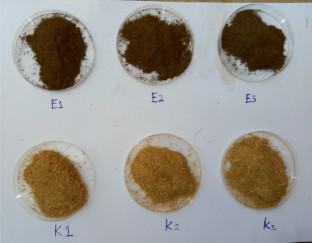Brazilian Journal of Botany ( IF 1.4 ) Pub Date : 2023-04-19 , DOI: 10.1007/s40415-023-00881-0 Matthew Chidozie Ogwu , Moses Edwin Osawaru , Emmanuel Amodu , Frances Osamo

|
The systematics of plant taxa may be done using an integrated assessment of their morphological, anatomical, phytochemical and genetic characteristics, which may ultimately contribute to their sustainable utilization and value. This study adopts chemotaxonomy, morphometry and anatomical investigations to differentiate two Cissus species—Cissus populnea and Cissus rubiginosa. Results suggest only the leaves of C. rubiginosa contain flavonoids, whereas C. populnea leaves and roots contain starch, which is absent in the leaves and roots of C. rubiginosa. Saponin is present in the root of C. populnea and absent in C. rubiginosa root. The ground product of C. populnea root is light brown and dark brown in C. rubiginosa. Crude lipid content is higher in C. populnea than in C. rubiginosa in all the assessed parts. The leaf anatomy of both C. rubiginosa and C. populnea is isobilateral. However, more intercellular air spaces were observed in the leaf tissues of C. rubiginosa than in C. populnea. In addition, the adaxial leaf surface of C. populnea suggests an anomocytic stomata type with a conspicuous nucleus and starch grains in the parenchyma cell, whereas no visible stomata were observed in C. rubiginosa. The presence of trichomes in C. rubiginosa is notable, but a similar feature is absent in C. populnea. The stem anatomy of C. populnea reveals a solenostele–siphonostele arrangement, whereas C. rubiginosa shows a siphonostele arrangement. The root anatomy of both Cissus species is similar, but differences were observed in their leaf base, upper and lower surfaces, and leaf margin. Although the yellow-coloured flowers are umbel in both species, the fruit type is drupe in C. populnea and berry in C. rubiginosa. In conclusion, both Cissus species assessed in the study are distinguishable by their phytochemical constituents, anatomical features and phenotypic characteristics.
中文翻译:

两种 Cissus Linn 的比较形态学、解剖学和化学分类学。物种
植物类群的系统学可以通过对其形态学、解剖学、植物化学和遗传特征的综合评估来完成,这可能最终有助于它们的可持续利用和价值。本研究采用化学分类学、形态计量学和解剖学研究来区分两个Cissus种——Cissus populnea和Cissus rubiginosa。结果表明只有C. rubiginosa的叶子含有类黄酮,而C. populnea 的叶子和根含有淀粉,而C. rubiginosa的叶子和根中不存在这种物质。皂苷存在于C. populnea的根中,而在C. rubiginosa中不存在根。C._ _ _ rubiginosa。在所有评估部位,C. populnea的粗脂含量高于C. rubiginosa 。C. rubiginosa和C. populnea的叶解剖结构是等双侧的。然而,在C. rubiginosa的叶组织中观察到比在C. populnea中更多的细胞间隙。此外,C. populnea的近轴叶表面表明气孔类型不规则,在薄壁细胞中具有明显的核和淀粉粒,而在C. rubiginosa中没有观察到可见的气孔. C. rubiginosa中存在毛状体是值得注意的,但C. populnea中没有类似的特征。C. populnea的茎解剖结构显示出一种管状中柱-管状中柱排列,而C. rubiginosa则显示出管状中柱排列。两种Cissus的根解剖结构相似,但在叶基、上表面和下表面以及叶缘方面存在差异。虽然这两个物种的黄色花都是伞形花序,但C. populnea 的果实类型是核果,C. rubiginosa 的果实类型是浆果。总之,Cissus研究中评估的物种可通过其植物化学成分、解剖学特征和表型特征加以区分。





















































 京公网安备 11010802027423号
京公网安备 11010802027423号